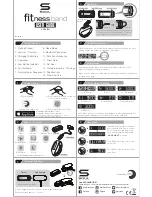
Drum Group Overview
949
Drum Group
Overview
The
Drum Group
allows up to three different
Drum
or
Melodic Patterns
(of equal or different lengths) to be
created, edited, and simultaneously looped, while
being separately modified by various other
parameters. Many of these modifications are controlled
by settings in the Phase Group. This allows you to set
up effects where various things happen only on certain
steps of the Phase Pattern; such as a four bar Drum
Pattern which is randomized with a Cluster Pattern
every fourth time through (bars 13–16).
About Drum Patterns
A Drum Pattern is a special type of “fixed” pattern that
contains Note Numbers. These can be used to
construct Drum and Percussion Patterns, or Melodic
Patterns of a more fixed nature than what is generated
by using the Note Series Group. Although you can
create Drum Patterns with any mixture of notes you
desire, a basic concept used throughout the available
GEs was to have the three patterns (and three Drum
Template Banks) follow these basic rules:
Pattern 1/Bank 1: Kick, Snare, and Tom Notes
Pattern 2/Bank 2: Hi-Hat, Ride, and Cymbal Notes
Pattern 3/Bank 3: Percussion Notes
This allows you to mix and match Kick/Snare Patterns
with different Hi-Hat Patterns and Percussion
Patterns, allowing great flexibility and variation.
Drum Patterns with more than one sound turned on in
a column can operate either “polyphonically”
(generating more than one drum note at a time) or as
random “pools,” where a random choice will be made
from one of the drum sounds in the column. The
bottom row of each grid allows a rest to be placed as a
step, or added to the pools for the possibility of a rest.
A Drum Pattern consists of only Note Numbers and
rests; there are no durations, no velocities, no rhythms.
The other information is supplied by the Rhythm,
Velocity, Cluster, and other Patterns. It helps to think in
terms of straight 16ths (or 32nds) while constructing
new patterns. You can of course later play the Drum
Patterns with Rhythm Patterns different values, for
more variations.
A Drum Pattern will loop as long as note generation
continues. The 3 separate Patterns are independently
loopable, so they can be of different lengths; a 4 bar
Kick/Snare Pattern can be used with a 2 bar Hi-hat
Pattern and a 3 bar Percussion Pattern, etc. They
normally will not reset to the beginning of the Pattern
unless a new Trigger is received, or unless the Phase
Pattern has been configured to restart them at the
beginning of certain Phases. This also means that a
sixty-four step Drum Pattern can be looping while an
eight step Velocity Pattern and a twelve step Cluster
Pattern are also independently looping, for example.
The riff or arpeggio that would normally be being
produced if the “GE Type” (
0: Generated-
Riff
is still being generated internally. Therefore, if
Index Patterns, Cluster Patterns, or Velocity Patterns
are being used by the GE, these can be applied to the
Drum Patterns with very interesting results, causing
randomization and quasi-improvisational effects. The
GEs included in the OASYS make use of this effect in
the Drum RTC Model, on the “Randomize/Improvise”
slider.
These randomizations are controlled by settings in the
Phase Pattern. This allows effects where various things
happen only on certain steps of the Phase Pattern; such
as a four bar Drum Pattern which is randomized with a
Velocity Pattern every fourth time through (bars 13–
16).
Also, the same riff or arpeggio can be applied to the
resulting drum rhythms as Pitch Bend values, on the
Bend Group. This results in “Wave-Sequencing” effects
and other unique sounds. The included GEs use this
feature in the Drum RTC Model on Switch 6. Each step
in the Phase Pattern can have Pitch Bend activated for
that particular step. This means that you can do
something like have no Pitch Bend through three steps
and then have Pitch Bend on the fourth step.
Pattern Editing Grid & Associated Parameters
Drum Pattern
A Drum Pattern is a grid of 8 rows by 64 columns. The
bottom row of the grid is the “Rest” row; the other 7
rows correspond to 7 Drum Sounds or Notes that have
been chosen to construct the pattern. A Drum Pattern
may have any number of steps up to 64, with each step
being represented by one column on the grid; unused
columns appear disabled.
The example above shows a kick, snare, toms and
maracas pattern, where the bottom two rows in the top
part of the grid have their corresponding Drum Sound
menus set to kick and snare. The bottom row of rests
are interleaved with the kick and snare choices to form
a groove to be played with a straight 32nd note
Rhythm Pattern. Therefore, the entire grid represents a
2 bar phrase of 4/4 time, with every 8 columns
representing 8 32nd notes (1 quarter note).
Содержание Electronic Keyboard
Страница 1: ...Parameter Guide Parameter Guide ...
Страница 2: ......
Страница 180: ...Program mode EXi 170 ...
Страница 290: ...EXi STR 1 Plucked String 280 ...
Страница 572: ...Sequencer mode 562 ...
Страница 700: ...Global mode 690 ...
Страница 751: ...Insert Effects IFX1 IFX12 Routing 741 Fig 2 3a Fig 2 3b ...
Страница 902: ...Effect Guide 892 ...
















































